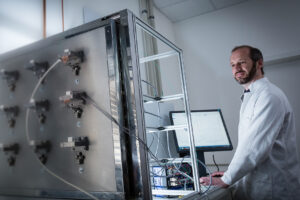Motivation, Problemstellung, wissenschaftliche und technische Projektziele
As part of the MaterialDigital project, it was demonstrated for the first time that materials can be integrated into digital value chains in the sense of Industry 4.0. For this purpose, digital representations of the processed materials (so-called material twins) were generated from a material data space for the two use cases of metals and polymers during the manufacturing process, thereby achieving consistency of the material status information along the process chains under consideration. This has the advantage that the processes can subsequently be optimised with regard to the desired local, physical or mechanical properties of the materials.
PROJECT RESULTS
The integration of materials in value chains in the sense of Industry 4.0 was demonstrated using two use cases. The aim here was to use digital twins to ensure the consistency of material properties that vary in terms of location and time along the value chain or product life cycle.
In the metals application (in which the fem was involved), the aluminium gravity die casting process with subsequent two-stage heat treatment (solution annealing and artificial ageing) was considered. The casting alloy AlSi10Mg served as an example alloy. In two casting campaigns, test bars were initially cast on the fem in order to build up a project-specific database for filling the material data space by means of mechanical and analytical material characterisation. In the second casting campaign, a demonstrator cast component was cast at the fem, which was subjected to static bending stress on a laboratory test stand at the IWM. In both casting campaigns, the chemical composition of the AlSi10Mg alloy was varied in terms of the silicon and magnesium content within the scope of the specification.The casting campaigns were accompanied by casting simulations at fem, whose detailed model parameters were fine-tuned by comparing them with temperature measurements in the test rod mould. Various gating systems for the mould of the demonstrator casting were considered and tested using the mould filling simulation at fem. As direct mould filling from above was very uneven and unfavourable due to the resulting turbulence, an ascending casting was preferred. Two variants of this were designed: one with the sprue channel connected to the lower part of the component and one with the use of a so-called knife cut. The latter was selected, with an additional widening of the knife-cut sprue to reduce turbulence during mould filling. In this case, the casts were also carried out with temperature measurements.
Two objectives were pursued: Firstly, all data from the characterisation campaign of the test bars was structured with the help of the developed digital workflow, the data sets of individual process steps were linked with each other and the final coherent knowledge graph of the process chain was transferred to a graph database. Using the domain ontology developed at the IWM for the process chain under consideration, it was possible to show that expert knowledge on the influence of chemical composition and heat treatment parameters on different mechanical properties can be extracted from the material data space. In addition to the retrieval of pure metadata, tensile tests were also used to demonstrate that the heterogeneous raw data sets can be accessed automatically. The material data room technology thus demonstrably represents a future-oriented form of digital knowledge representation of material and process-specific expert knowledge and forms the basis for further data-based analyses. Based on the specific example, decisions can be made regarding the choice of heat treatment parameters depending on the chemical composition in order to achieve a specific material strength.
Secondly, the demonstrator component was used to show that the integration of a digital twin into simulation and evaluation chains enables more precise statements to be made about the functionality of the component. The twin maps the geometry, the internal material structure, locally varying material properties and characteristic values from the process history and ensures consistency along the process chain under consideration. A graphical user interface was developed at the IWM for the necessary fusion of the material data, which can be used to visualise and correlate locally distributed material and process parameters in a component.
Acknowledgement
We would like to thank the Baden-Württemberg Ministry of Economic Affairs, Labour and Housing for funding this project as part of its support for business-related research projects relating to the implementation of the digitalisation strategy in the field of digitalisation: Opportunities for sustainability and the energy transition.
